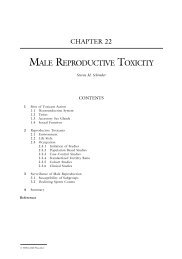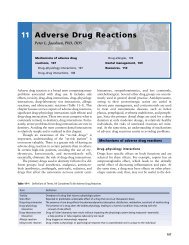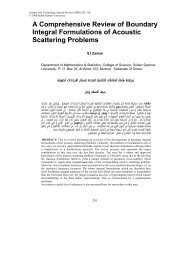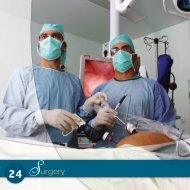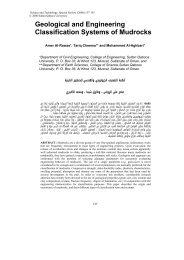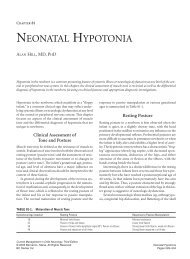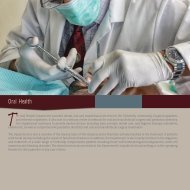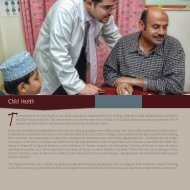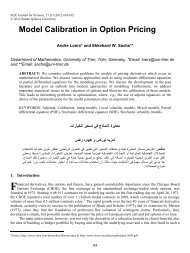Ch05: Red and White Lesions of the Oral Mucosa
Ch05: Red and White Lesions of the Oral Mucosa
Ch05: Red and White Lesions of the Oral Mucosa
You also want an ePaper? Increase the reach of your titles
YUMPU automatically turns print PDFs into web optimized ePapers that Google loves.
<strong>Red</strong> <strong>and</strong> <strong>White</strong> <strong>Lesions</strong> <strong>of</strong> <strong>the</strong> <strong>Oral</strong> <strong>Mucosa</strong> 105<br />
FIGURE 5-32 Epi<strong>the</strong>lium showing full-thickness change (ie, carcinoma<br />
in situ) <strong>and</strong> central area <strong>of</strong> severe dysplasia. Dysplastic cells have enlarged<br />
hyperchromatic nuclei, cellular <strong>and</strong> nuclear pleomorphism, an increased<br />
nucleocytoplasmic ratio, <strong>and</strong> (most importantly) a generalized loss <strong>of</strong> cellular<br />
polarity <strong>and</strong> orientation. Note central pink (cytoplasm-rich) area <strong>of</strong> “normal”<br />
epi<strong>the</strong>lium. (Hematoxylin <strong>and</strong> eosin, ×65 original magnification)<br />
Definitive treatment involves surgical excision although<br />
cryosurgery <strong>and</strong> laser ablation are <strong>of</strong>ten preferred because <strong>of</strong><br />
<strong>the</strong>ir precision <strong>and</strong> rapid healing. 153–155 Total excision is aggressively<br />
recommended when microscopic dysplasia is identified,<br />
particularly if <strong>the</strong> dysplasia is classified as severe or moderate.<br />
Most leukoplakias incur a low risk for malignant transformation.<br />
Following attempts at removal, recurrences appear when ei<strong>the</strong>r<br />
<strong>the</strong> margins <strong>of</strong> excision are inadequate or <strong>the</strong> causative factor or<br />
habit is continued. In any event, such patients must be observed<br />
periodically because <strong>of</strong> <strong>the</strong> risk <strong>of</strong> eventual malignancy.<br />
The use <strong>of</strong> antioxidant nutrients <strong>and</strong> vitamins have not<br />
been reproducibly effective in management. Programs have<br />
included single <strong>and</strong> combination dosages <strong>of</strong> vitamins A, C, <strong>and</strong><br />
E; beta carotene; analogues <strong>of</strong> vitamin A; <strong>and</strong> diets that are<br />
high in antioxidants <strong>and</strong> cell growth suppressor proteins (fruits<br />
<strong>and</strong> vegetables). 156–158<br />
Prognosis<br />
After surgical removal, long-term monitoring <strong>of</strong> <strong>the</strong> lesion site<br />
is important since recurrences are frequent <strong>and</strong> because additional<br />
leukoplakias may develop. 159,160 In one recent series <strong>of</strong><br />
<strong>the</strong>se lesions, <strong>the</strong> recurrence rate after 3.9 years was 20%. 143<br />
Smaller benign lesions that do not demonstrate dysplasia should<br />
be excised since <strong>the</strong> chance <strong>of</strong> malignant transformation is 4 to<br />
6%. 140 For larger lesions with no evidence <strong>of</strong> dysplasia on biopsy,<br />
<strong>the</strong>re is a choice between removal <strong>of</strong> <strong>the</strong> remaining lesion <strong>and</strong><br />
follow-up evaluation, with or without local medication.<br />
Repeated follow-up visits <strong>and</strong> biopsies are essential, particularly<br />
when <strong>the</strong> complete elimination <strong>of</strong> irritants is not likely to be<br />
achieved. In such cases, total removal is strongly advisable.<br />
Follow-up studies have demonstrated that carcinomatous transformation<br />
usually occurs 2 to 4 years after <strong>the</strong> onset <strong>of</strong> leukoplakia<br />
but that it may occur within months or after decades. 159<br />
Each clinical appearance or phase <strong>of</strong> leukoplakia has a different<br />
potential for malignant transformation. Speckled leukoplakia<br />
carries <strong>the</strong> highest average transformation potential,<br />
followed by verrucous leukoplakia; homogeneous leukoplakia<br />
carries <strong>the</strong> lowest risk. For dysplastic leukoplakia, <strong>the</strong> clinician<br />
must consider <strong>the</strong> histologic grade when planning treatment<br />
<strong>and</strong> follow-up. In general, <strong>the</strong> greater <strong>the</strong> degree <strong>of</strong> dysplasia,<br />
<strong>the</strong> greater <strong>the</strong> potential for malignant change. In addition,<br />
multiple factors play a role in determining <strong>the</strong> optimum management<br />
procedure. These factors include <strong>the</strong> persistence <strong>of</strong><br />
<strong>the</strong> lesion over many years, <strong>the</strong> development <strong>of</strong> leukoplakia in<br />
a nonsmoker, <strong>and</strong> <strong>the</strong> lesion’s occurrence on high-risk areas<br />
such as <strong>the</strong> floor <strong>of</strong> <strong>the</strong> mouth, <strong>the</strong> s<strong>of</strong>t palate, <strong>the</strong> oropharynx,<br />
or <strong>the</strong> ventral surface <strong>of</strong> <strong>the</strong> tongue.<br />
▼ BOWEN’S DISEASE<br />
Bowen’s disease is a localized intraepidermal squamous cell<br />
carcinoma <strong>of</strong> <strong>the</strong> skin that may progress into invasive carcinoma<br />
over many years. Bowen’s disease also occurs on <strong>the</strong> male<br />
<strong>and</strong> female genital mucosae <strong>and</strong> (rarely) in <strong>the</strong> oral mucosa as<br />
an erythroplakic, leukoplakic, or papillomatous lesion. 161<br />
Bowen’s disease occurs most commonly on <strong>the</strong> skin, as a<br />
result <strong>of</strong> arsenic ingestion. It grows slowly as an enlarging ery<strong>the</strong>matous<br />
patch, with little to suggest a malignant process. The<br />
histologic picture is very characteristic, with <strong>the</strong> epi<strong>the</strong>lium<br />
exhibiting a significant loss <strong>of</strong> cellular polarity <strong>and</strong> orientation,<br />
increased <strong>and</strong> abnormal mitoses, multiple highly atypical hyperchromatic<br />
nuclei, <strong>and</strong> cellular pleomorphism. Individual cell<br />
keratinization at different levels <strong>of</strong> <strong>the</strong> epi<strong>the</strong>lium is seen. <strong>Lesions</strong><br />
<strong>of</strong> this type are <strong>of</strong>ten associated with visceral cancer. 161,162<br />
Because <strong>of</strong> <strong>the</strong> clinical <strong>and</strong> histologic similarity between<br />
Bowen’s disease <strong>and</strong> erythroplakia (both <strong>of</strong> which can be characterized<br />
as red patches <strong>of</strong> <strong>the</strong> mucous membrane that histologically<br />
contain severely dysplastic epi<strong>the</strong>lium or intraepi<strong>the</strong>lial<br />
carcinoma), <strong>the</strong> question has been raised as to whe<strong>the</strong>r<br />
<strong>the</strong>y are <strong>the</strong> same disorder. 162 Current opinion, based on <strong>the</strong><br />
comparison <strong>of</strong> oral erythroplakias with <strong>the</strong> oral lesions <strong>of</strong><br />
Bowen’s disease, holds that <strong>the</strong>y are separate disorders. 162<br />
A nodular, benign, <strong>and</strong> virus-associated epi<strong>the</strong>lial dysplasia<br />
with a histologic picture resembling Bowen’s disease<br />
(bowenoid papulosis) occurs on <strong>the</strong> genital mucosa <strong>of</strong> sexually<br />
active young adults <strong>and</strong> has been reported on multiple oral<br />
mucosal surfaces on rare occasions. 163<br />
▼ ERYTHROPLAKIA<br />
Erythroplakia has been defined as a “bright red velvety plaque<br />
or patch which cannot be characterized clinically or pathologically<br />
as being due to any o<strong>the</strong>r condition.” 164 The word





